Home Decor
Interior Decor for Tiny Spaces: Big Style in Small Rooms!
You’ll discover how to transform tiny spaces into stunning retreats, but wait until you see the innovative ideas that can elevate your interior decor!
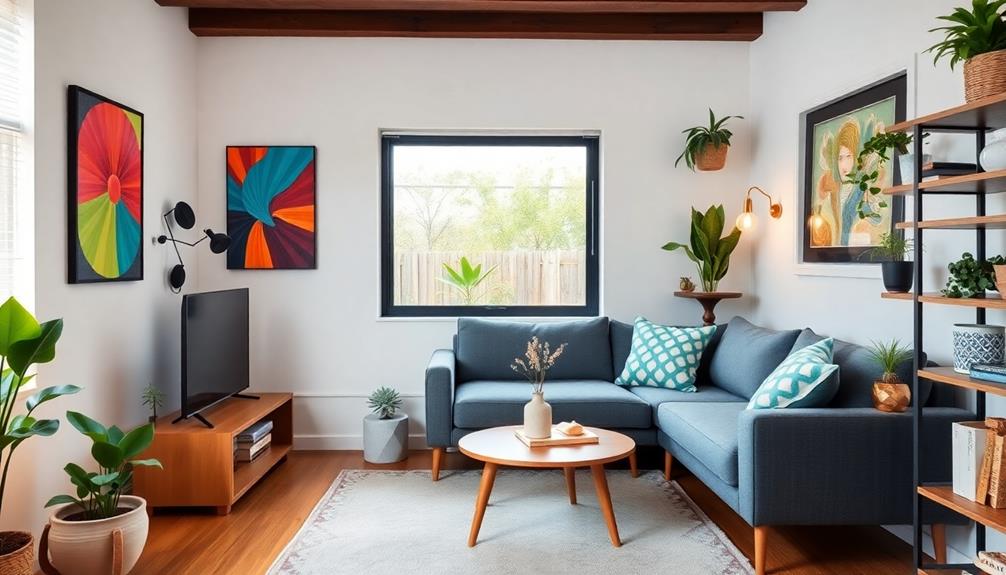
You can easily turn tiny spaces into stylish retreats with smart design choices. Start by using multipurpose furniture like sofa beds and storage ottomans to maximize functionality. Opt for light colors and minimalism to create an airy feel. Incorporate vertical storage solutions, such as wall-mounted shelves, to free up floor space. Consider reflective elements to enhance brightness and depth. Unconventional layouts can improve flow, while custom pieces cater to your unique needs. With these tips, your small room can boast big style. Keep exploring for more innovative ideas to elevate your interior decor!
Key Takeaways
- Utilize multipurpose furniture like sofa beds and storage ottomans to maximize functionality in small spaces.
- Implement vertical storage solutions such as wall-mounted shelves to free up floor space and enhance organization.
- Choose light-colored and minimalistic furniture to create a sense of openness and balance within the room.
- Incorporate layered lighting to establish a warm and inviting atmosphere while meeting various functional needs.
- Customize furniture for unique layouts to optimize efficiency and reflect personal style in irregularly shaped rooms.
Maximizing Small Space Functionality
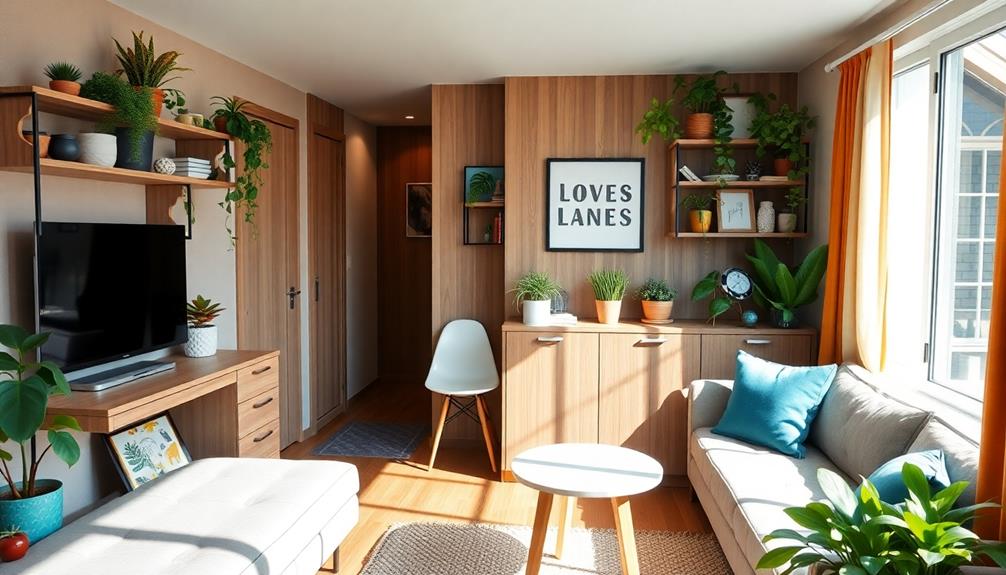
Maximizing functionality in tiny spaces can transform your living area into a well-organized haven. To make the most of your limited square footage, consider implementing multipurpose furniture. A sofa bed or a storage ottoman serves dual roles, offering both seating and extra storage without taking up unnecessary room.
Additionally, incorporating natural materials like wood and bamboo in your decor can add warmth and a touch of the outdoors, creating a calming atmosphere reminiscent of Balinese design characteristics.
You can also utilize vertical storage solutions like wall-mounted shelves or high cabinets. This approach frees up floor space and keeps your belongings neatly organized.
Don't forget about those cleverly designed nooks and corners; they can become practical spaces, such as a small home office or a cozy reading nook, ensuring you maximize every inch effectively.
Incorporating hidden storage options, such as under-bed compartments or built-in shelving, helps maintain a clutter-free environment while optimizing available space.
Choosing the Right Furniture
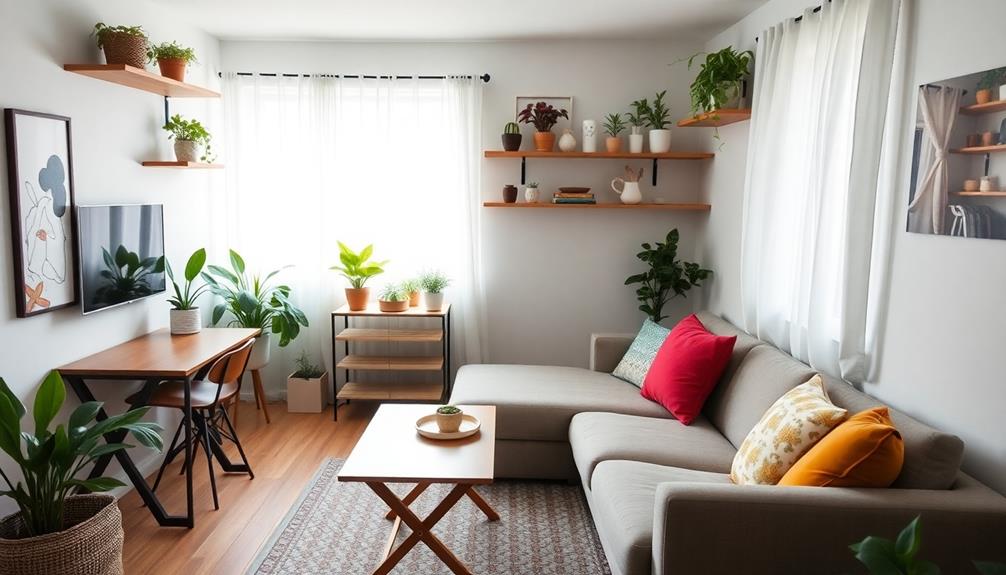
When choosing furniture for tiny spaces, it's essential to take into account scale and proportion to avoid a cramped feeling.
Emphasizing minimalism, you can create a safe and clutter-free environment that feels more open.
Opt for light-colored, multi-functional pieces that enhance openness while serving multiple purposes, such as space maximization.
Scale and Proportion
Choosing the right furniture for tiny spaces can make all the difference in creating a comfortable and inviting environment. Focus on scale and proportion when selecting your pieces. Oversized furniture can overwhelm a small room, making it feel cluttered.
Instead, choose appropriately sized items that enhance openness and flow, much like the principles of Balinese indoor-outdoor living that emphasize seamless connectivity and harmony. Low-profile coffee tables and small round tables are excellent choices since they occupy less visual weight and allow for easier movement.
When it comes to sofas, opt for a slim design rather than a bulky sectional, as this greatly improves the overall balance and proportion of your space. Additionally, consider the height and visual lines of your furniture. Lower pieces can create a sense of spaciousness, while taller items draw the eye upward, enhancing the perception of height.
Incorporating multi-functional furniture, like ottomans that serve as both seating and storage, maximizes utility without sacrificing style.
Multi-Functional Pieces
In the domain of tiny spaces, embracing multi-functional pieces can dramatically enhance your living experience. Choosing the right multi-functional furniture, like sofa beds and storage ottomans, allows you to make good use of your limited space while eliminating the need for extra items. This not only keeps your room tidy but also guarantees it feels bigger and more inviting.
Consider incorporating Indonesian decorative pillows that bring vibrant colors and intricate patterns, adding a cultural touch while providing comfort.
Consider selecting folding tables or modular shelving that adapt to your needs, giving you flexibility without overcrowding your area. Investing in furniture with built-in storage, such as benches or coffee tables with compartments, helps maintain a clutter-free environment.
Low-profile designs, like lightweight chairs and small round tables, create an open feel, making your space appear larger while still serving essential functions.
Light-Color Furniture Choices
Opt for light-colored furniture to create an illusion of spaciousness in your tiny space. Choosing light-color furniture choices, like whites, creams, and soft pastels, can make your small rooms feel more open and airy. These hues reflect natural light, enhancing brightness and inviting warmth into compact living areas.
Additionally, consider incorporating natural materials like jute or linen, which can complement light colors while adding texture and warmth to your decor. This approach enhances the overall flow of the room, making it feel more organized and expansive. Combining Aesthetic and Nautical Room Decor can also inspire you to add subtle nautical elements that maintain a light and breezy atmosphere.
Select smaller, low-profile furniture pieces in these light shades to avoid overwhelming your space. This approach enhances the overall flow of the room, making it feel more organized and expansive.
Additionally, opt for sleek designs with minimalistic features to reduce visual clutter—this can have a huge impact on how you perceive the room.
To add depth without sacrificing openness, incorporate light-colored accessories such as cushions or throws. These elements can introduce texture while maintaining a cohesive look that complements your furniture.
Creative Multipurpose Designs
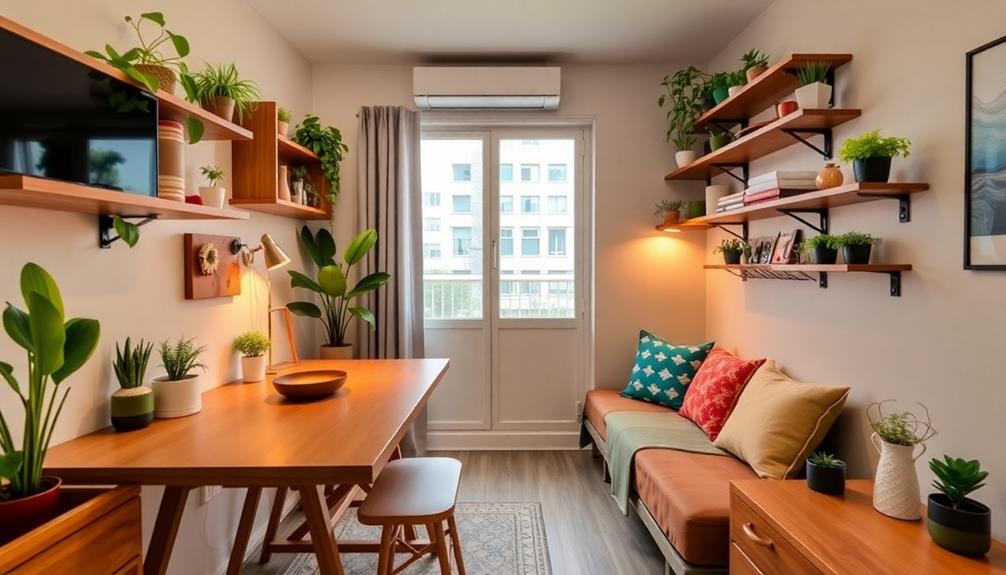
Creativity shines in multipurpose designs, especially when it comes to maximizing tiny spaces. You can transform your living area into a guest room with versatile multipurpose furniture like sofa beds or storage ottomans, minimizing clutter while enhancing functionality.
Incorporating elements from luxury tropical design aesthetics can also elevate the ambiance of small spaces. Horizontal Murphy beds are another innovative solution, effortlessly converting a bedroom into an office without sacrificing style.
Foldable tables and chairs are essential for small dining areas, allowing you to store them compactly when not in use, yet easily accommodating more guests during gatherings.
Smart designs, such as built-in bookshelves and wall-mounted desks, utilize vertical space effectively, creating additional functionality without taking up valuable floor space.
Modular furniture pieces offer adaptability and can reconfigure to suit various layouts and activities. This flexibility allows you to change your living space according to your needs, enhancing usability and aesthetics.
Innovative Storage Solutions
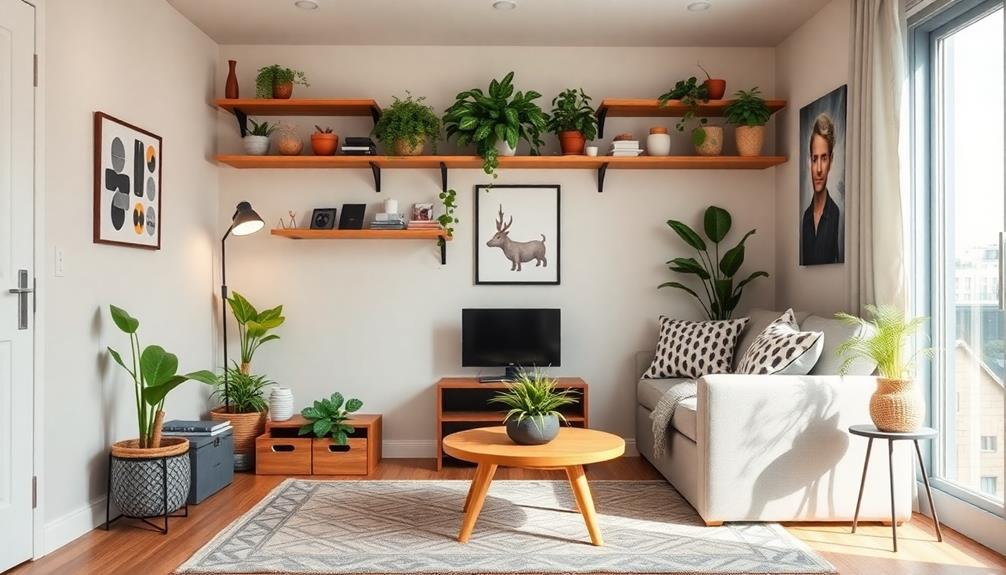
When you're working with limited space, innovative storage solutions can be a game-changer.
Consider incorporating multifunctional furniture that not only provides seating but also hides away your belongings, maximizing both style and functionality.
Think about utilizing hidden options like under-bed compartments or vertical shelves that free up floor space while keeping your essentials organized.
Hidden Storage Options
How can you make the most of limited space while keeping your home organized? Embrace hidden storage options that allow you to maximize every inch of your tiny rooms. Built-in furniture, like benches and ottomans, can conceal storage without sacrificing style, helping you maintain a chic look while keeping clutter at bay.
Additionally, consider incorporating traditional Indonesian housing concepts, which often feature elevated structures and multifunctional designs that promote efficient use of space.
Consider under-bed storage solutions, such as drawers or boxes, to keep seasonal clothing and other items hidden yet easily accessible. This clever tactic maximizes your bedroom space, ensuring that you utilize even the areas often overlooked.
Wall units are another fantastic way to integrate shelving and storage seamlessly. They help you stay organized while adding visual interest to your decor.
Multi-functional furniture is a game changer, too; think coffee tables with hidden compartments or sofas with storage built into the base. These pieces considerably reduce clutter and enhance functionality in your living area.
Vertical Storage Solutions
Maximizing vertical space can transform tiny areas into functional, organized havens. By implementing vertical storage solutions, you can effectively utilize unused wall space, enhancing both the functionality and aesthetic of your small living room.
Consider installing wall-mounted shelves and cabinets; these not only keep your belongings organized but also free up valuable floor area. To add a touch of Bohemian charm, consider incorporating wall art or decorative hangings that reflect your personal style.
Opt for tall bookshelves or vertical cabinets that reach upward, providing ample storage without crowding your space. You can also use pegboards or wall hooks for a creative way to organize tools and accessories, keeping surfaces clear and items easily accessible.
Don't forget about the charm of vertical gardens or wall-mounted planters. These not only save space but also introduce greenery, improving air quality in your tiny environment.
Incorporating furniture pieces with built-in vertical storage, like multi-functional shelving units or storage ottomans, can help you maintain a clutter-free atmosphere while adding style.
Customization for Unique Spaces
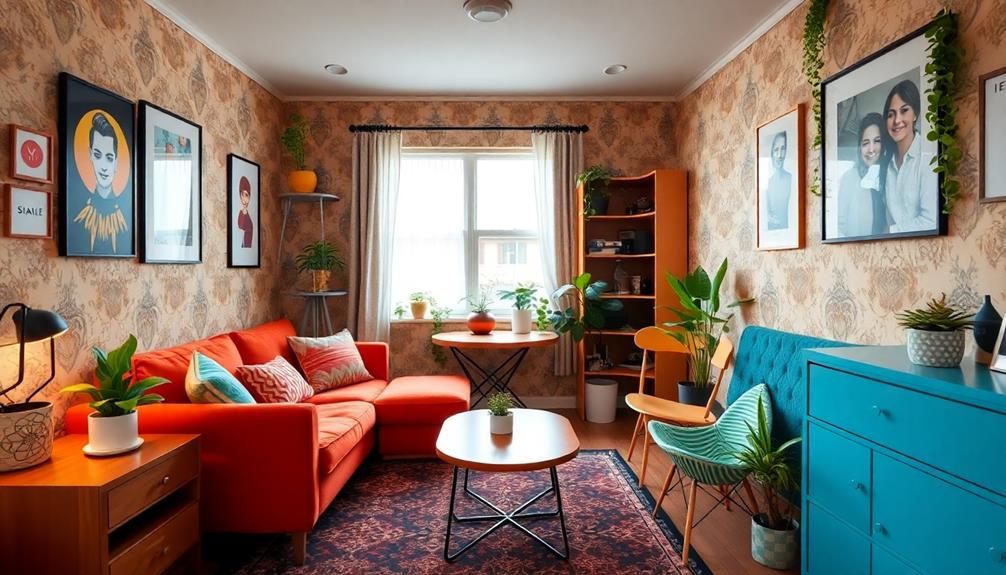
Creating a cozy and functional home in a tiny space often requires a touch of customization. With custom furniture designed to fit your room's irregular dimensions, you can guarantee every inch is utilized efficiently. Tailored pieces, like built-in shelving or unique cabinetry, not only address specific storage needs but also reflect your personal style.
Additionally, incorporating elements from tropical villa plans can enhance the open and airy feel of your tiny space.
Consider incorporating non-traditional designs, such as wall-mounted desks or foldable tables, which maximize functionality without compromising aesthetics. These pieces can be easily tucked away when not in use, keeping your space open and inviting.
Additionally, creative configurations, like multi-level platforms or lofted beds, transform underused vertical space into practical and stylish solutions, optimizing every corner of your home.
Investing in custom solutions enhances the overall flow and usability of your tiny space. You'll find that a personalized approach not only meets your specific needs but also creates a harmonious environment that feels uniquely yours.
Enhancing Aesthetics With Decor
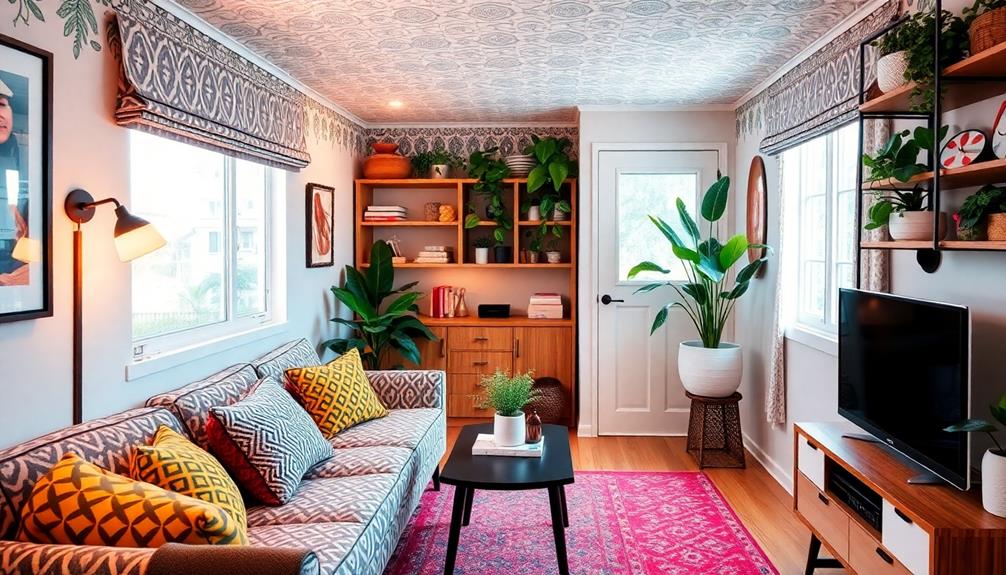
Customizing your tiny space not only enhances functionality but also sets the stage for aesthetics that truly reflect your style. To elevate your room's look, consider some smart design ideas. Wall-mounted fixtures and shelves keep the floor clear, making it feel larger and more organized. This simple trick helps create a seamless, open environment.
Another effective styling trick is to place mirrors opposite windows. This strategy maximizes natural light and creates an illusion of depth, which can transform your space dramatically. Additionally, using light colors in your decor—like soft hues or whites—will reflect light and contribute to an airy atmosphere. You'll discover that these choices make small spaces feel more inviting.
When it comes to decor pieces, opt for a few impactful items instead of overcrowding the area. This approach not only allows your personal style to shine through but also creates an elegant and cohesive look.
Utilizing Color and Light
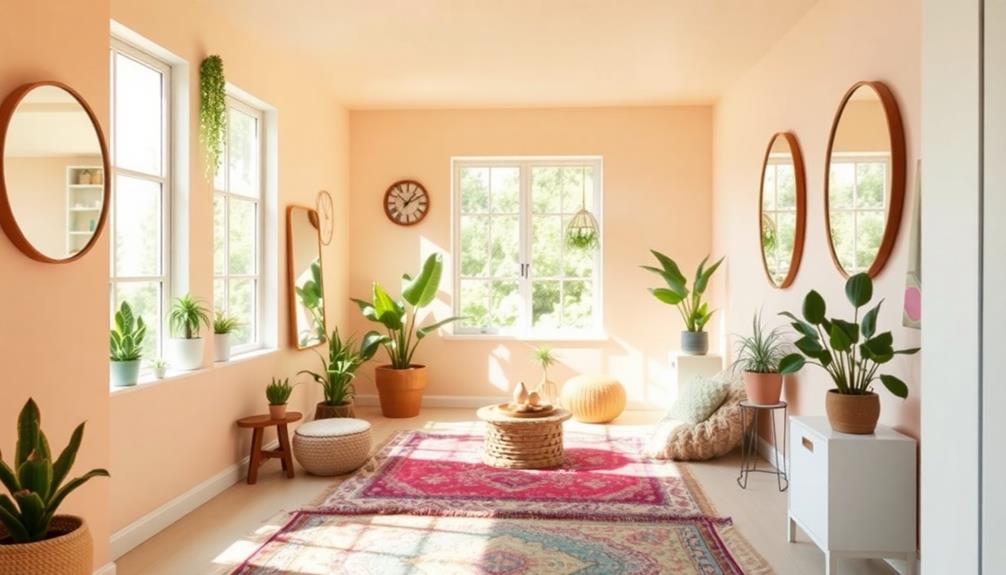
Color and light play an essential role in altering tiny spaces into inviting havens. To maximize your small area, consider painting the walls and ceiling in light colors like whites and soft pastels. These hues greatly increase light reflection, making the room feel larger and more open.
A monochromatic color palette can also help create a seamless shift between surfaces, enhancing that sense of continuity.
Incorporate mirrors strategically, especially opposite windows, to enhance natural light and visually expand the space. This simple addition can work wonders in making the room feel airy and bright.
You can introduce bright accent colors through decor items like cushions or artwork, injecting personality and vibrancy without overwhelming the small area.
Layered lighting is another key component. Combine ambient, task, and accent lighting to enhance the overall ambiance and functionality of your room.
This approach not only makes the room feel more inviting but also allows you to adapt the lighting to suit different activities, enhancing comfort throughout the day.
Smart Layout Configurations

When it comes to maximizing tiny spaces, smart layout configurations can make all the difference in how the area feels and functions. Consider unconventional layouts like L-shaped or U-shaped arrangements to improve flow and interaction between furniture pieces.
Zoning areas within the room is vital; strategically placing rugs can define distinct spaces for dining or working, making each area purposeful.
To enhance comfort and safety, avoid sharp corners and choose round tables or furniture with soft edges. This small change creates a more inviting atmosphere.
Don't forget about utilizing vertical space! Tall shelving units or wall-mounted fixtures draw the eye upward, keeping the floor clear and giving the illusion of height.
Integrating multi-functional furniture is another important element. Items like ottomans that double as storage or foldable tables allow you to adapt the layout for varying needs without overcrowding the space.
Incorporating Reflective Elements

Incorporating reflective elements can dramatically transform tiny spaces, making them feel more open and inviting. One of the simplest ways to achieve this is by using mirrors. They create an illusion of depth, reflecting light and your surroundings, which can make any small kitchen or living area appear larger.
Here are some effective ways to incorporate reflective elements:
- Strategically place mirrors: Position them opposite windows to maximize natural light and enhance that spacious feel.
- Use high-shine surfaces: Opt for glossy tiles and lacquered furniture that amplify brightness, contributing to an airy atmosphere.
- Decorative mirrors: Choose mirrors that double as art pieces. They can add visual interest while still providing practical benefits.
Frequently Asked Questions
How Do You Make a Small Room Look Bigger Interior Design?
To make a small room look bigger, use light colors on walls, place mirrors opposite windows, choose appropriately sized furniture, implement vertical storage, and arrange furniture for clear pathways to enhance spaciousness and flow.
How Do You Make a Big Room Feel Small and Cozy?
To make a big room feel small and cozy, use warm colors, layer lighting, arrange furniture into intimate groupings, add soft textiles, and personalize with decor. These elements create an inviting, snug atmosphere you'll love.
How to Make a Small Space Look Expensive?
To make a small space look expensive, choose a light color palette, invest in plush textiles, hang large artwork, select multi-functional furniture, and layer diverse lighting. These elements create sophistication and elevate your space's overall aesthetic.
How to Decorate a Narrow Space?
To decorate a narrow space, you'll want to use vertical storage, light colors, and slim furniture. Add mirrors for depth, and define areas with rugs to create an organized, open feel. You'll love the results!
Conclusion
In tiny spaces, you can achieve big style by maximizing functionality, choosing the right furniture, and embracing innovative storage solutions. You'll create a cozy atmosphere by incorporating reflective elements, utilizing color and light, and customizing your decor to fit your unique needs. With smart layout configurations and creative multipurpose designs, you'll transform your small room into a stylish haven. Remember, it's not about the size; it's about the style and how you make every inch count! To achieve a stylish look in a small space, consider incorporating minimalist interior decor tips. This can include choosing streamlined furniture, opting for a neutral color palette, and decluttering your space to create a sleek and modern feel. Embracing a minimalist approach will not only make your room look more spacious, but it will also help you maintain a clean and organized living environment. Ultimately, by implementing these strategies, you can make the most out of your tiny space and create a stylish, functional, and inviting home.
Home Decor
Feng Shui Secrets Designers Swear By to Create a Calm and Harmonious Home
I uncover essential Feng Shui secrets that designers rely on to cultivate a peaceful home, but there’s so much more to discover for ultimate serenity.
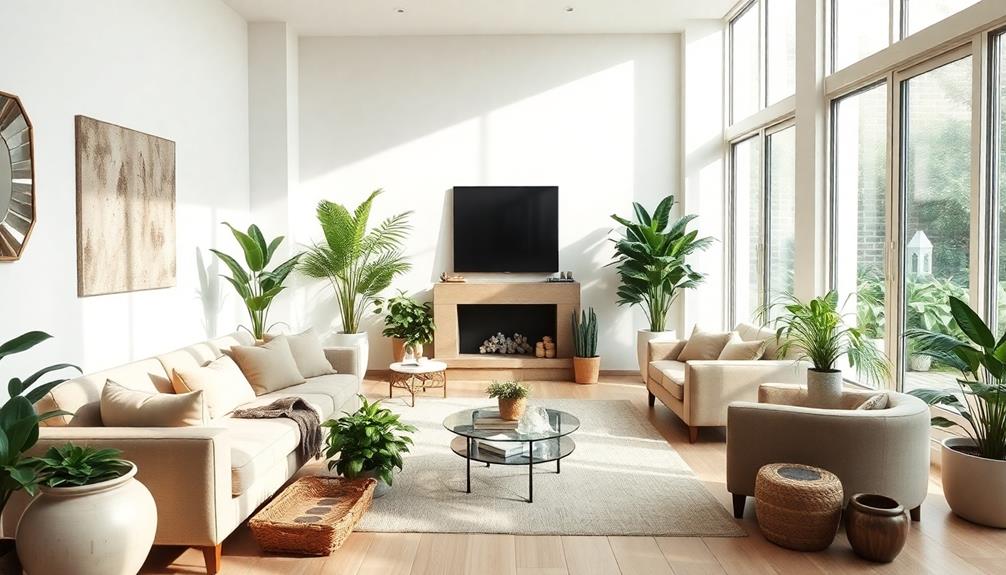
To create a calm and harmonious home, embrace Feng Shui principles that designers swear by. Start by using a Bagua map to identify energy flow in each area. Incorporate the five elements—Wood, Fire, Earth, Metal, Water—into your decor for balance. Prioritize soothing colors like green for family harmony and red for love. Avoid clutter to keep energy flowing freely and position furniture to enhance security and conversation. Use mirrors to amplify light and include natural elements, such as rounded-leaf plants. These strategies lay the foundation for a serene atmosphere, and you'll discover even more effective tips ahead.
Key Takeaways
- Utilize a Bagua map to identify specific areas of your home that correspond to different life aspects for targeted energy enhancement.
- Embrace soothing color palettes, like greens for family harmony and pinks for love, to create a calming environment.
- Position furniture in a command position, allowing for a clear view of the entrance, to promote security and positive energy flow.
- Maintain cleanliness and organization, especially in high-traffic areas, to prevent stagnation and enhance the flow of Chi.
- Introduce natural elements, such as rounded-leaf plants and mirrors, to amplify light and energy while fostering a nurturing atmosphere.
Understanding Feng Shui Principles
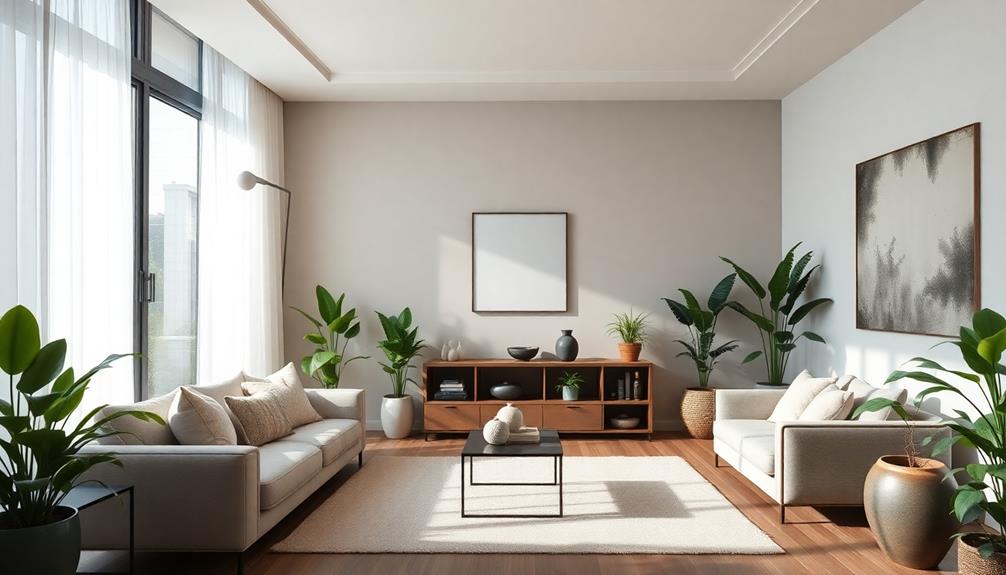
Understanding Feng Shui principles can transform your living space into a sanctuary of peace and balance. This ancient Chinese practice emphasizes the flow of energy, or Chi, in your environment. By making minor adjustments, you can create significant improvements in your quality of life.
Incorporating elements of Balinese design characteristics can enhance the natural flow of energy and create a harmonious atmosphere. The five elements of Feng Shui—Wood, Fire, Earth, Metal, and Water—are vital for achieving balance and harmony in your home. Each element links to specific colors and shapes that enhance positive energy.
Utilizing the Bagua map can guide your design decisions, as it divides your space into nine areas that correspond to different aspects of life, such as career and relationships.
Incorporating Yin and Yang concepts guarantees that opposing forces are harmonized, promoting well-being and tranquility. Proper furniture placement is essential; positioning key items in a commanding position and avoiding sharp corners facilitates a smooth energy flow.
Essential Feng Shui Tools
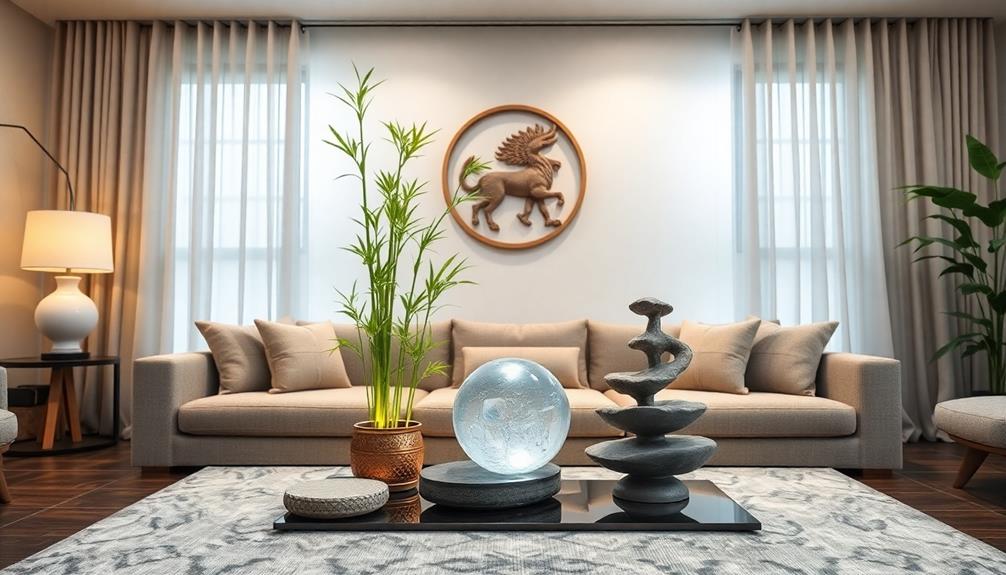
To create a harmonious environment, you'll want to utilize specific Feng Shui tools that enhance the flow of positive energy in your home. One of the most essential tools is the Bagua Map, which divides your space into nine areas, each reflecting different life aspects. Use this map to identify where to focus your energy improvements.
Incorporating Feng Shui Symbols like Buddha statues or wind chimes can greatly enhance positive energy flow and shield against negativity. Additionally, the Five Elements—Wood, Fire, Earth, Metal, and Water—should be included in your decor to balance the elements and support various life aspects.
Additionally, consider the color palette in your interior design ideas. Specific colors promote different energies, such as pink and red for love or green for finances.
Here's a quick reference table for your Feng Shui toolkit:
| Tool | Purpose |
|---|---|
| Bagua Map | Identify focus areas for energy flow |
| Feng Shui Symbols | Enhance positive energy and protection |
| Five Elements | Balance energies in decor |
| Color Palette | Promote desired outcomes |
Key Dos and Don'ts
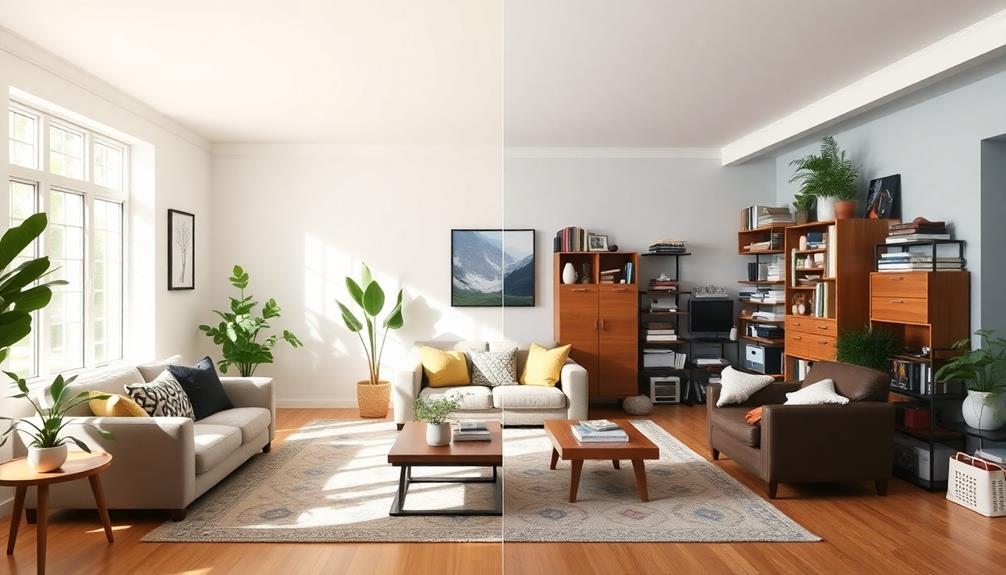
When it comes to creating a calm home with Feng Shui, following key Dos and Don'ts can make all the difference.
First, embrace Feng Shui tips by using soothing colors in your space. Opt for green to enhance family harmony and red to invite love, boosting positive energy throughout your home. Incorporating elements like Indonesian decorative pillows can add vibrant colors and intricate patterns that enhance the ambiance.
On the other hand, don't let clutter accumulate; it obstructs energy flow (Chi) and can lead to feelings of stagnation and stress.
Next, pay attention to furniture placement. Make sure your furniture is in a command position, ideally placed diagonally from the entrance. This setup fosters a sense of security and control.
Conversely, avoid sharp-edged furniture or decor, as they can create negative energy (Sha Qi) and discomfort in your environment.
Room-Specific Guidelines
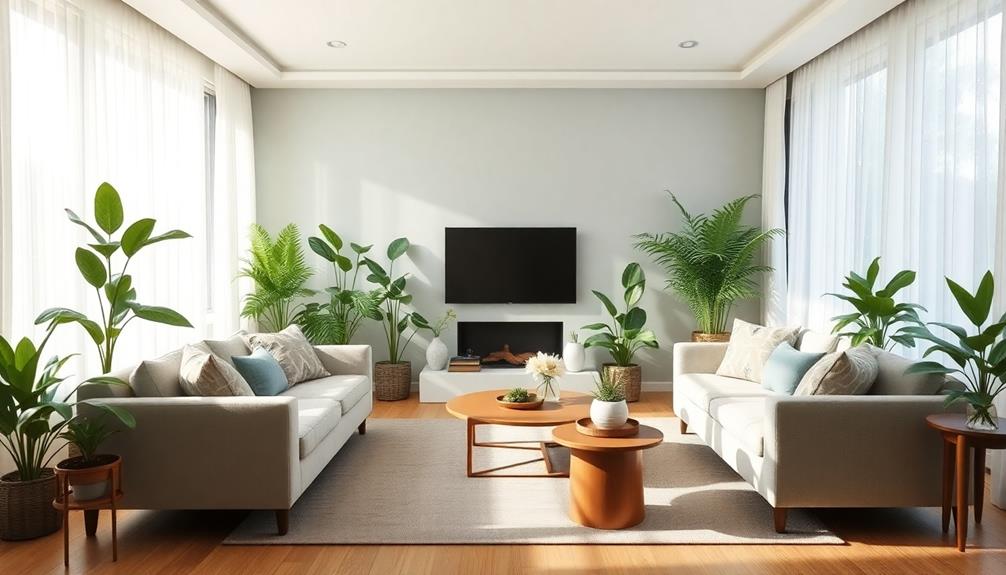
Creating a calm environment goes beyond general principles; it requires attention to each room's unique energy. For example, incorporating elements from luxury tropical designs can enhance the tranquility of your living space.
In your living room, position furniture to promote positive energy flow and encourage conversation. Soft lighting and comfortable seating create a peaceful and calming atmosphere, enhancing social interaction.
For the kitchen, keep the stove and sink clean and clutter-free. Ascertain your fridge is well-stocked and place the stove in a commanding position to optimize energy in your home.
In the bedroom, arrange your bed to have a clear view of the door, using calming colors like soft blues or greens. This creates balance and promotes restful sleep by minimizing distractions from electronics.
Maintain cleanliness in your bathroom, using soft lighting for a serene feel. Keep the toilet lid down and doors closed to preserve privacy and positive energy.
For your home office, position your desk to face the entrance, giving you a sense of control. Ascertain your workspace is organized and filled with natural light to enhance productivity and focus.
Incorporating small touches of color red can also invigorate your space, promoting smooth and uninterrupted energy flow.
Enhancing Energy Flow

Enhancing energy flow in your home is vital for fostering a calm and inviting atmosphere. To achieve this, it's important to create clear pathways, allowing Chi to circulate freely.
Regular decluttering is important; removing unnecessary items prevents stagnation and promotes positive energy to flow throughout your space. Incorporating elements of modern tropical aesthetics in Bali can further enhance this flow, as they emphasize natural materials and open layouts that invite light and air.
Consider the flow of your furniture. Positioning it diagonally from the entrance creates a commanding view, giving you a sense of control and security. This simple adjustment can greatly enhance the overall energy dynamics of your room.
Incorporating mirrors is another effective way to amplify light and energy, especially in darker areas. They not only brighten spaces but also create a visual expansion, making the environment feel more open and harmonious.
Lastly, introduce natural elements like plants with rounded leaves to invigorate your space, promoting a nurturing vibe.
These small changes contribute to creating balance and harmony in your home. By focusing on these strategies, you'll cultivate an environment where energy that flows effortlessly supports your well-being and tranquility.
Frequently Asked Questions
How to Bring Peace at Home Feng Shui?
To bring peace at home, clear clutter to enhance energy flow, position furniture for security, use soothing colors, incorporate warm lighting, and add natural elements like plants to foster a calming atmosphere.
What Is Bad Feng Shui for a House?
Beware of bad feng shui! If your entrance faces a staircase, sharp corners threaten comfort, clutter clogs chi, dark areas dampen mood, and broken items breed stagnation. Tidy up to transform your space!
What Are the Feng Shui Rules for a House?
To create positive energy in your house, follow basic Feng Shui rules. Position your entrance welcomingly, declutter spaces, arrange furniture for comfort and visibility, and incorporate natural elements like plants to enhance harmony and flow.
How to Make a House Lucky Feng Shui?
To make your house lucky, position your entrance for clear views, incorporate the five elements in your decor, keep spaces clutter-free, use mirrors for light, and enhance areas linked to wealth and health.
Conclusion
Just like a well-tended garden thrives, your home flourishes when you embrace Feng Shui principles. By nurturing the energy flow and respecting the essential tools, you transform your space into a tranquil oasis. Remember, a calm home reflects a calm mind, much like a still pond mirrors the sky. So, as you rearrange and refine your surroundings, envision your home as a sanctuary where peace blossoms, inviting harmony into every corner of your life.
Home Decor
The Feng Shui Furniture Rule That Will Instantly Improve Your Space
Get ready to transform your space with the Feng Shui furniture rule that promotes harmony and flow—discover how to elevate your environment today!
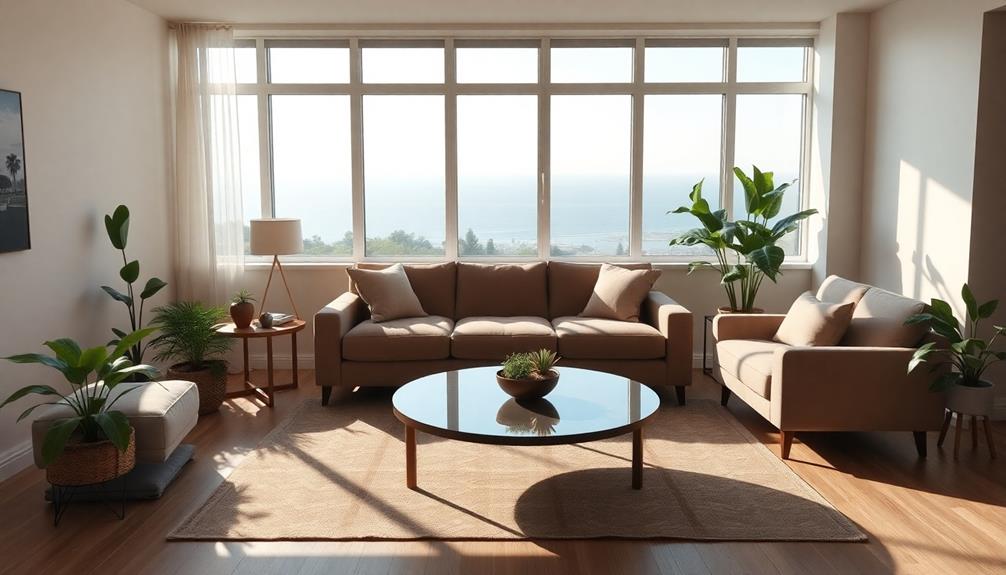
To instantly improve your space, position your furniture in the command position. This means placing key pieces like your bed or desk in a way that you can see the entrance while feeling supported by a solid wall behind you. Avoid pushing furniture against windows or corners to keep energy flowing. Make sure pathways are clear for easy movement. Adding natural elements, like plants, enhances this flow further. With a few tweaks, you can create a harmonious and inviting atmosphere. If you want to explore more ways to elevate your space, there's much more to discover!
Key Takeaways
- Position beds and desks in the command position to enhance energy flow and visibility of entrances for greater comfort and relaxation.
- Clear pathways and avoid clutter to facilitate movement, preventing energy stagnation and promoting tranquility within your space.
- Incorporate natural elements like plants to ground energy and refresh the atmosphere, enhancing vitality in your environment.
- Use soothing colors that resonate with you to influence mood and create a calming ambiance throughout your living space.
- Regularly reassess and update your furniture arrangement to align with personal growth, seasonal changes, and evolving preferences.
Understanding the Command Position

When you understand the command position, you can considerably enhance the flow of energy in your home. The command position refers to the strategic placement of furniture, particularly your bed and desk, allowing you to see the entrance while maintaining distance from direct sightlines. Incorporating elements like Indonesian decorative pillows can further enhance your space with their vibrant colors and intricate patterns, promoting a warm and inviting atmosphere. This setup fosters a sense of security and control, promoting relaxation.
In the bedroom, position your bed against a solid wall, ensuring you have visibility of the door while keeping pathways clear for ideal energy flow. This arrangement not only creates a peaceful sanctuary but also enhances your overall well-being.
In your living room, placing seating in a command position encourages conversation and interaction, enhancing the overall social atmosphere. Similarly, in your home office, position your desk to face the entrance, empowering you to feel aware of your surroundings while you work.
Avoid placing furniture against windows or crammed into corners, as this can disrupt energy flow and create feelings of vulnerability.
Balancing Energy Flow

Mastering the command position sets the foundation for a harmonious living space, but balancing energy flow takes it a step further. To truly enhance your environment, focus on furniture arrangements that create clear pathways and avoid clutter. This allows energy to circulate freely and prevents stagnation.
Consider the following elements to improve your space:
| Element | Importance |
|---|---|
| Clear Pathways | Promote movement and prevent obstruction. |
| Natural Elements | Incorporate plants for grounding energy. |
| Soothing Colors | Use soft tones to enhance tranquility. |
| Visibility of Front Door | Foster comfort and reduce anxiety. |
Position larger furniture pieces to encourage interaction while ensuring visibility of entrances. This not only nurtures a sense of security but also supports social connections. Regularly reassess your furniture arrangement and embrace seasonal decor changes to maintain ideal energy flow. By doing so, you'll create a clutter-free environment that radiates balance and tranquility, transforming your space into a calming sanctuary. Prioritizing these aspects of Feng Shui will elevate your living experience and promote a serene atmosphere for you and your guests. Incorporating feng shui furniture ideas can also inspire creative layouts that maximize both functionality and harmony within your space. Consider using round tables to encourage equality in conversations or placing mirrors strategically to reflect natural light and amplify positive energy. These thoughtful adjustments will further align your home with Feng Shui principles, enhancing its overall warmth and inviting ambiance.
Optimal Furniture Placement
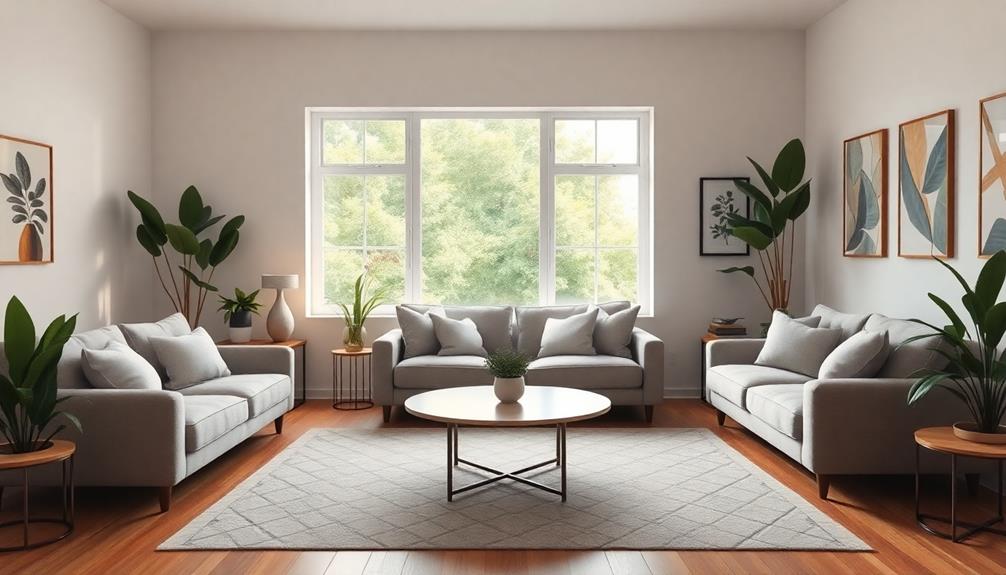
Optimal furniture placement is vital for creating a harmonious living space that promotes positive energy flow. To achieve ideal furniture placement, position larger pieces, like sofas, away from walls. This setup encourages an inviting atmosphere and facilitates conversation while ensuring you can see the front door for a sense of security.
Incorporating elements from Balinese design characteristics can further enhance the energy of your space by blending traditional craftsmanship with modern aesthetics. Avoid placing the back of the sofa against a window, as this blocks energy flow and may lead to feelings of instability.
Arrange seating to promote easy movement and interaction, keeping pathways clear to enhance overall energy. Incorporating natural elements, such as plants, can ground your space and elevate the energy. Place these near natural light sources for ideal growth, as they contribute to a vibrant environment.
Regular reassessments of your furniture arrangement are essential. By making seasonal adjustments, you can refresh your space, ensuring it continues to support your emotional well-being.
Always be open to tweaking your layout; sometimes, a simple shift can greatly enhance positive energy flow and create a more inviting atmosphere. Embrace these strategies to cultivate a space that nurtures both you and your guests.
Personalizing Your Space
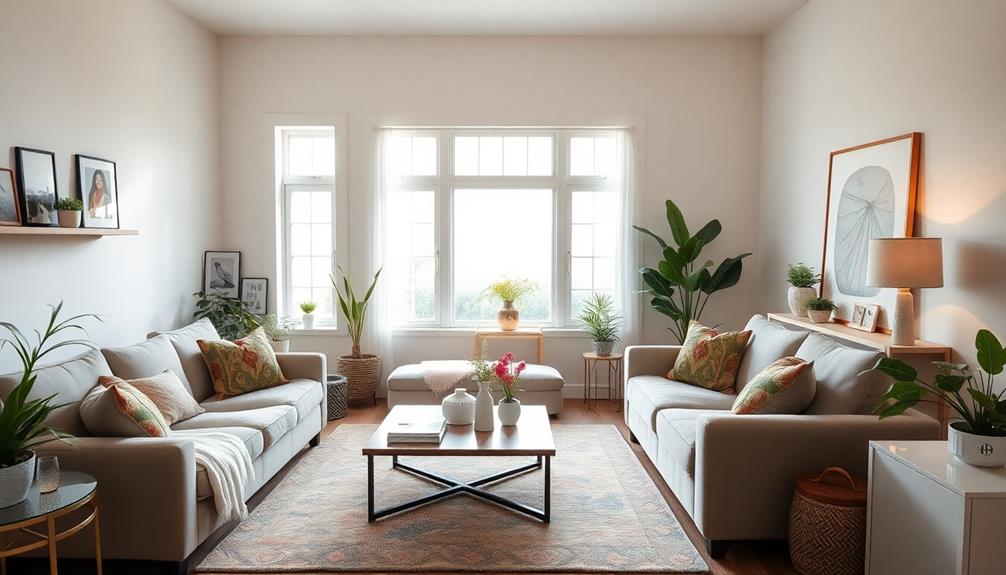
Personalizing your space transforms it into a reflection of who you are, making it feel more like home. Start by incorporating sentimental items like family photos or meaningful artwork, such as a unique Indonesian decor mask that represents rich cultural heritage. These pieces enhance your emotional connection to the space, fostering a sense of belonging.
Choose colors that resonate with you; they can greatly influence your mood and energy levels, promoting a calming atmosphere.
Don't forget to bring in natural elements such as plants and wood materials. These additions ground your space and provide a revitalizing connection to nature.
Regularly reassessing your decor allows you to reflect seasonal changes or personal growth, maintaining ideal energy flow and liveliness in your living area.
Thoughtful placement is key. Grouping objects in odd numbers can create visual appeal and elevate the overall harmony of the room.
Maintaining Harmony Over Time

Maintaining harmony in your space is essential for fostering a positive and inviting atmosphere. To guarantee your environment promotes ideal energy flow, regularly reassess your furniture arrangement. Seasonal changes often call for adjustments, so keep your space feeling fresh and welcoming.
| Action | Purpose |
|---|---|
| Declutter | Prevent stagnant energy |
| Incorporate | Utilize natural elements |
| Personal items | Evoke positive emotions |
| Schedule updates | Keep energy dynamic |
| Refresh energy | Create a calming atmosphere |
By decluttering consistently, you'll prevent stagnant energy, allowing tranquility to flourish. Incorporating natural elements like plants can further refresh energy, creating a calming atmosphere that nurtures your well-being. Don't forget to include personal items that evoke positive emotions, enhancing the overall harmony of your space.
Lastly, schedule periodic updates to your decor and furniture placement. This keeps your living space aligned with your evolving preferences and lifestyle. Embrace these practices to maintain harmony over time, guaranteeing your home remains a sanctuary that supports your journey to well-being.
Frequently Asked Questions
How to Feng Shui Your Space?
To feng shui your space, arrange furniture for clear pathways, promote conversation with seating, incorporate natural elements, use calming colors, declutter regularly, and strategically place mirrors to enhance light and energy flow.
How to Place Furniture According to Feng Shui?
Placing furniture's like arranging a dance; you want partners to face each other. Position your seating to encourage conversation, clear pathways for movement, and always guarantee a view of the door for security and comfort.
How Can I Improve My Room Feng Shui?
To improve your room's feng shui, position your bed for visibility of the door, declutter pathways, use soothing colors, add plants, and regularly reassess your arrangement for ideal energy flow and tranquility.
How Do You Arrange Furniture for Positive Energy?
To arrange furniture for positive energy, create clear pathways, position seating to face the door, encourage conversation with your layout, and incorporate natural elements. Regularly refresh arrangements to maintain an uplifting atmosphere in your space.
Conclusion
By following these feng shui principles, you can transform your space into a sanctuary that feels both inviting and balanced. Remember, it's all about creating harmony and flow. Have you considered how your furniture placement affects your daily energy? With a little mindfulness and personalization, you'll not only enhance your surroundings but also elevate your mood. Keep reassessing and adjusting as needed to maintain that perfect balance and guarantee your space continues to inspire you.
Home Decor
Why These 5 Feng Shui Principles Will Make Your Home Feel Complete
Transform your living space with these five Feng Shui principles that promise harmony and balance—discover how they can make your home feel truly complete.
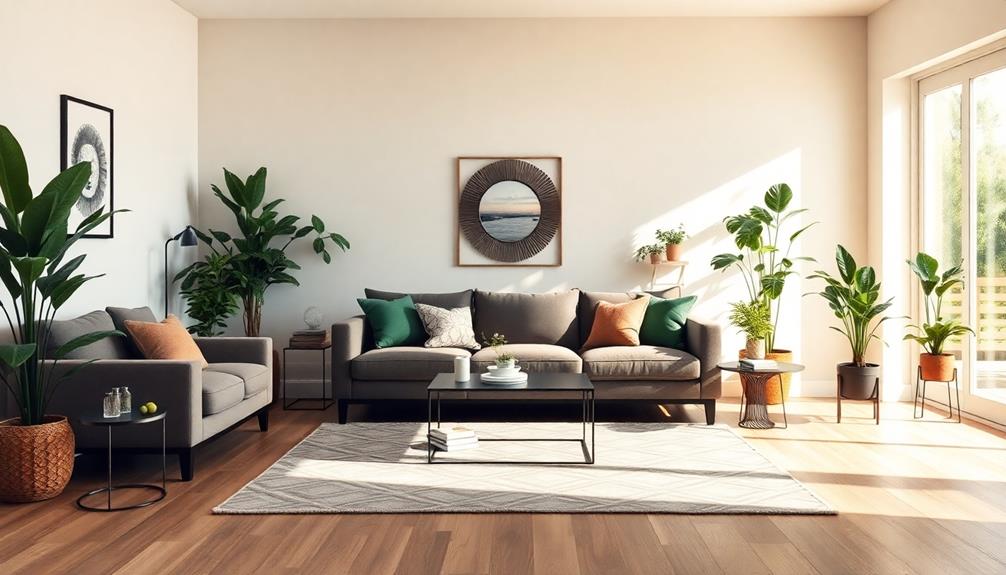
Incorporating these five Feng Shui principles can transform your home into a place of tranquility and balance. Start by decluttering to enhance energy flow and reduce stress, making your space feel inviting. Next, arrange your furniture strategically to promote good Chi and create functional zones. Thoughtful mirror placements can amplify light and positivity, while balancing the five elements in your decor fosters harmony and boosts relaxation. With these principles, you'll find your home feels complete and rejuvenating. Stick around to uncover even more ways to enhance your living space!
Key Takeaways
- Embracing Feng Shui principles enhances the flow of Chi, creating a lively and harmonious atmosphere in your home.
- Decluttering promotes positive energy circulation, reducing stress and chaos, leading to a more peaceful living space.
- Strategic furniture arrangement fosters an inviting environment, ensuring comfort and functionality in various areas of your home.
- Thoughtful use of mirrors boosts light and energy flow, reflecting positive elements and enhancing the overall ambiance.
- Balancing the five elements in design promotes relaxation and productivity, creating a sense of completeness and well-being in your home.
Understanding Feng Shui Principles
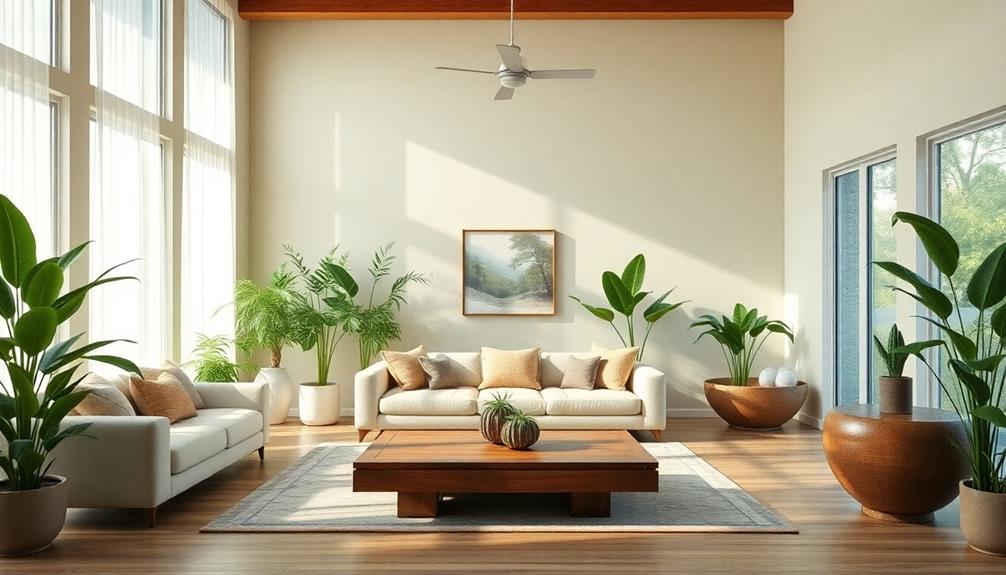
Feng Shui, an ancient Chinese practice, emphasizes the importance of energy flow, or Chi, in your living space. By understanding Feng Shui principles, you can create a balanced and harmonious environment that nurtures your well-being.
Central to this practice is the concept of Chi energy, which flows through your home, influencing your mood and liveliness. To enhance this flow of energy, consider incorporating elements of traditional Indonesian style home decor, which utilizes natural materials and emphasizes harmony with nature.
The Bagua Map serves as an essential tool, dividing your space into nine zones linked to different life aspects like wealth and health. Each zone can be activated by incorporating the five elements: Wood, Fire, Earth, Metal, and Water, ensuring a dynamic and organized space.
Feng Shui design also encourages the use of specific colors and materials to promote positive energy flow. For example, pink may attract love, while green can boost finances.
Additionally, integrating symbols like wind chimes or water features can further enhance the energy in your home.
Importance of Decluttering
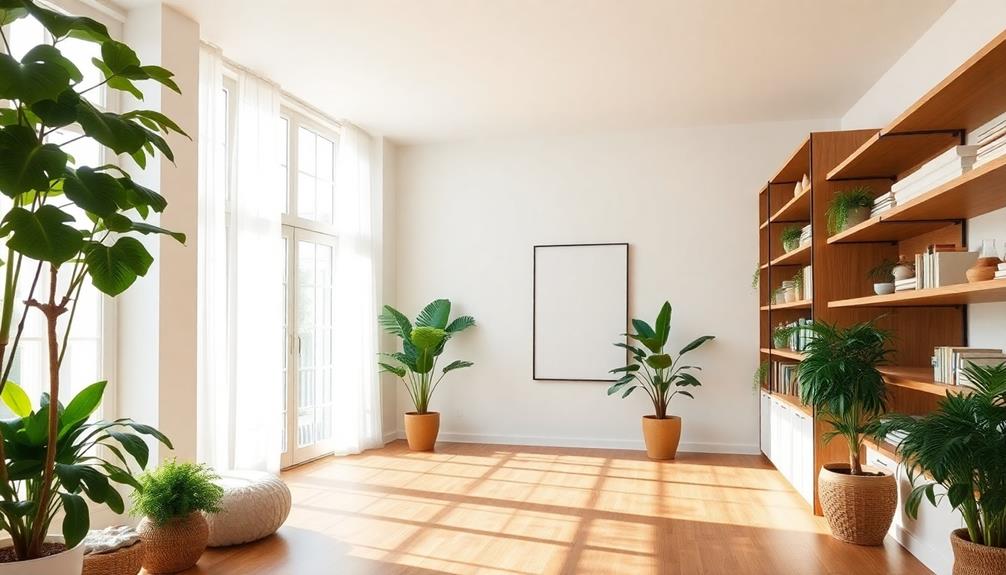
Decluttering is essential for maintaining a harmonious home, as it directly impacts the flow of chi, or energy, throughout your space. In Feng Shui, a clutter-free environment allows positive energy to circulate freely, enhancing your overall well-being. When you regularly declutter, you reduce chaos and stress, fostering mental clarity and emotional stability.
Here's how decluttering can transform your living space:
| Benefits of Decluttering | Effects on Well-being | Tips for Decluttering |
|---|---|---|
| Promotes positive energy | Reduces anxiety | Start small, focus on one area |
| Enhances relaxation | Improves sleep quality | Donate unused items regularly |
| Encourages creativity | Boosts mental clarity | Organize spaces effectively |
| Opens space for opportunities | Fosters emotional balance | Visualize your ideal space |
Strategic Furniture Arrangement

Arranging your furniture strategically can greatly enhance the flow of chi in your home, creating a more inviting and harmonious atmosphere. By positioning key pieces, like sofas and desks, to allow for clear visibility of entryways, you reduce feelings of vulnerability and boost comfort.
One essential element is placing your bed in a command position; ideally, it should face the door without being directly aligned with it. This arrangement promotes security and relaxation, crucial for restful sleep. Incorporating natural materials and earth tones, much like in Balinese interior design concepts, can further enhance the calming effect of your space.
Avoid sharp corners pointed toward seating areas, as they can foster discomfort and anxiety, disrupting your harmonious living space. Instead, utilize furniture to create distinct functional zones within a room. This encourages energy flow and supports various activities, enhancing the overall utility and vibe of your space.
Regularly reassessing your furniture placement can help maintain a balanced environment, allowing you to make adjustments that reflect your changing needs and preferences.
Thoughtful Use of Mirrors

Mirrors can be powerful tools in your home when used thoughtfully, enhancing both light and energy flow. In Feng Shui, the strategic placement of mirrors can greatly impact your living space.
For instance, incorporating elements like traditional artistry through vibrant Indonesian decor masks can complement the energy reflected by mirrors. Position them to reflect positive elements like plants or artwork, which amplifies good energy and promotes a sense of spaciousness.
Avoid placing mirrors directly facing beds or front doors, as this can lead to restlessness and energetic chaos. To maintain a peaceful environment, consider covering mirrors at night. This simple action helps mitigate any negative effects on your sleep, allowing for a more restful night.
Large mirrors can create the illusion of more space, but be cautious not to reflect clutter or negative imagery, as this can disrupt harmony in your home. Regularly evaluate your mirror placements to verify they support the desired energy flow and atmosphere in each room.
An organized approach to mirrors not only reflects your style but also contributes to a serene atmosphere, fostering positive energy throughout your home. Thoughtful use of mirrors can transform your space, making it feel complete and inviting.
Balancing Elements in Design
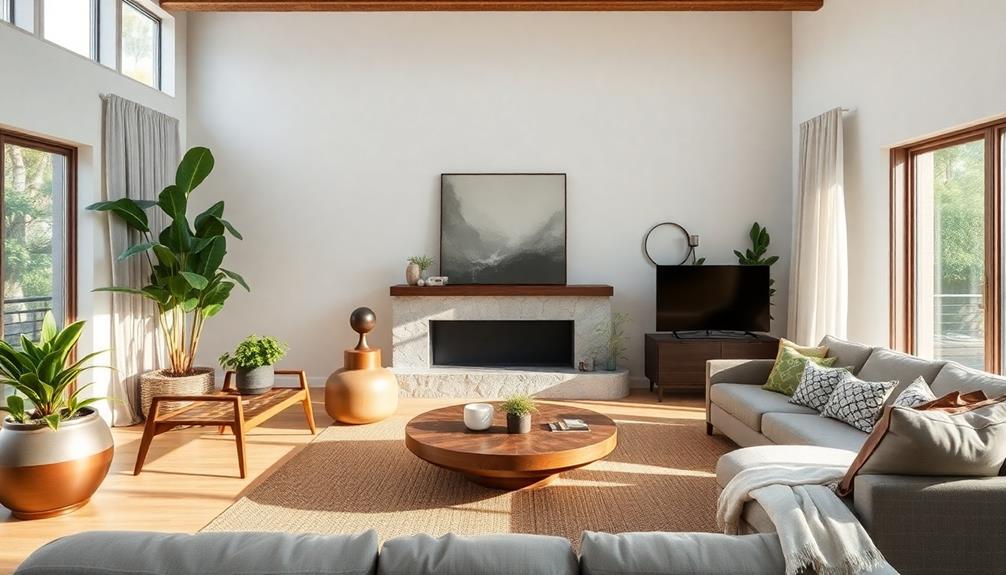
How can you create a harmonious environment in your home? Balancing the five elements—wood, fire, earth, metal, and water—is crucial for enhancing energy flow and promoting relaxation. Each element influences mood and energy, so incorporating them thoughtfully in your home design can greatly improve the quality of your space.
For example, vibrant colors and intricate patterns found in Indonesian decorative pillows can enhance the wood element, evoking feelings of growth and liveliness, while metal accents can provide clarity and structure. Understanding how these elements interact helps you avoid deficiencies; adding water features or blue decor can counteract excessive fire energy, ensuring balance and harmony throughout your home.
Utilizing Feng Shui principles, a chart can guide you in identifying which elements are lacking in your space. This way, you can make informed design choices that foster emotional and physical well-being.
Aiming for a balanced element composition not only enhances your home's aesthetic appeal but also creates a peaceful and calming atmosphere, boosting relaxation and productivity. With these adjustments, you'll cultivate a harmonious environment that resonates with positive energy and tranquility.
Frequently Asked Questions
What Are the 5 Principles of Feng Shui?
The five principles of Feng Shui are Chi Flow, Yin and Yang, the Five Elements, Clutter Clearing, and the Bagua Map. Each principle helps you create a balanced, harmonious, and energetically supportive home environment.
What Are the 5 Elements of Feng Shui?
The five elements of Feng Shui are Wood, Fire, Earth, Metal, and Water. Each element represents unique qualities and energies that influence your space and well-being, guiding you to create a harmonious environment.
How to Use Feng Shui in Your Home?
Transforming your home into a sanctuary could feel like magic! You can use feng shui by decluttering, arranging furniture wisely, adding natural elements, choosing soft colors, and enhancing lighting to create a harmonious, inviting space. Incorporating a feng shui color palette can further elevate the energy in your home, promoting balance and positivity. Opt for soothing hues like gentle greens, calming blues, or warm earth tones to foster a sense of peace and well-being. These thoughtful design choices not only enhance the visual appeal of your space but also nurture your emotional and spiritual connection to your environment.
How Important Is Feng Shui in a House?
Feng Shui's essential for your house because it optimizes energy flow, creating a balanced environment. When you embrace its principles, you enhance your well-being, promote relaxation, and foster a sense of harmony in your space.
Conclusion
By applying these five feng shui principles, you can create a harmonious space that feels complete and inviting. Decluttering not only clears physical space but also promotes mental clarity. When you arrange furniture thoughtfully and use mirrors strategically, you enhance energy flow. Balancing the five elements in your design fosters a sense of equilibrium. While some may debate the scientific basis of feng shui, many find that its practices enhance well-being, proving that intention can shape our environments profoundly.
-

 Mom5 months ago
Mom5 months agoHeartfelt Poems for Your Daughter’s Birthday
-

 Mom5 months ago
Mom5 months agoHappy Birthday Religious Wishes and Blessings
-

 Mom5 months ago
Mom5 months agoHappy 65th Birthday: Celebrate Your Special Day!
-

 Mom5 months ago
Mom5 months agoHappy Birthday in Heaven from Daughter: Remembering You
-

 Mom5 months ago
Mom5 months ago62nd Birthday Quotes for Mom: Celebrate Her Special Day
-

 Mom5 months ago
Mom5 months agoCelebrating 60 Years: Happy 60th Birthday Wishes
-

 Special Occasions4 months ago
Special Occasions4 months agoUplifting Words: Inspirational Church Anniversary Messages!
-

 Mom5 months ago
Mom5 months agoCelebrate a Joyous Happy 70th Birthday Milestone!

















